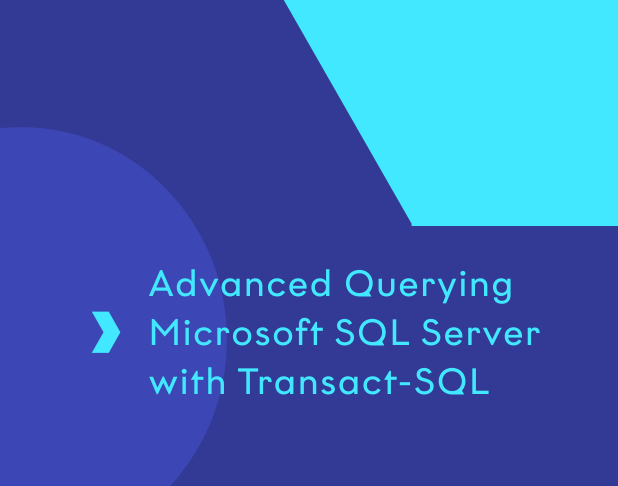Enhance your Transact-SQL skills with this advanced two-day course. Through practical exercises, you’ll explore complex querying, indexing and metadata techniques. Whether you’re looking to sharpen your reporting, improve database efficiency, or handle larger data sets, this course will help you take control of your SQL environment.
15% off eLearning, up to 20% off virtual courses - use code: EARLY1225USA
Advanced Querying Microsoft SQL Server with Transact-SQL
Select your learning method

Unlock faster, more efficient querying with advanced SQL training
In just two days, this T-SQL course helps you write efficient, complex queries, manage indexing strategies, extract metadata and improve performance – equipping you to work confidently in demanding SQL environments.
- Create and manage views
- Use advanced window functions
- Write common table expressions
- Utilise sequences and synonyms
- Retrieve schema metadata
- Pivot and group data effectively
- Design and manage indexes
- Manage complex table structures
- Optimise SQL query performance
What you’ll learn
Write faster, smarter SQL queries using advanced T-SQL tools. This course builds on your existing SQL knowledge and equips you with the skills to confidently manage complex data challenges. Learn how to structure queries using table expressions, perform sophisticated analysis with windowing functions, and manipulate grouped data with pivoting techniques.
Shaping data with pivoting and grouping
Learn how to organise and summarise complex datasets using advanced SQL grouping and pivoting techniques. This course teaches you how to reshape data with pivot and unpivot, making it easier to present results in a more readable format. You’ll also explore enhanced grouping tools such as grouping sets, rollup and cube, allowing you to generate comprehensive, multi-level summaries in a single query.
Managing tables, sequences and synonyms
Gain the skills to confidently manage tables and streamline your SQL workflows. You’ll learn how to create and modify tables effectively, apply constraints to protect data integrity, and use temporary tables for session-specific operations. The course also covers copying table structures for reuse and introduces sequences as a method for generating unique numeric values independently of table columns.
Improving query performance
Learn how to identify and resolve issues that affect the speed and efficiency of your SQL queries. This module introduces the key factors that impact performance, such as indexing strategies, query structure and resource usage. You’ll work with SQL Server tools to analyse execution plans, monitor performance metrics, and make data-driven adjustments that improve response times.
- 2 days of instructor-led training in a live virtual classroom
- Interactive hands-on live labs
- All relevant course materials
- Course completion certificate
Key facts
This course is perfect for developers, analysts, database administrators and anyone who already knows basic SQL and wants to take their skills further with more advanced querying techniques.
You should be confident writing simple SQL queries, having already completed a foundational course or regularly using SQL at work.
Our experienced trainers and interactive labs create a focused, practical environment – so you can put theory into practice from day one.
FAQs
Designed for professionals looking to build on their existing SQL knowledge and deepen their expertise, this course covers advanced Transact-SQL concepts helping you to work smarter and faster.
Will I be writing SQL code during the course?
Using our live labs, this hands-on course is packed with practical exercises, so you’ll gain plenty of experience writing and testing your own code.
How does indexing improve SQL query performance?
Indexing helps SQL Server locate and retrieve data more efficiently, much like an index in a book helps you find information quickly. By creating indexes on columns used in search conditions, joins or sorting, the database engine can avoid scanning entire tables, significantly reducing response times.
On this course, you’ll explore the different types of indexes and learn how to use them to boost performance. Also, gain practical experience creating, managing and dropping indexes, so you can make informed decisions about optimising queries in your own environment.
How do common table expressions (CTEs) simplify complex SQL queries?
CTEs help you break complex logic into clear, manageable components. By defining temporary result sets within your SQL statements, CTEs improve readability and allow you to write more modular, testable code. During the course, you’ll work with CTEs as part of a wider focus on table expressions, learning how to use them effectively to simplify nested queries and support scalable, maintainable database solutions.
What our customers say

"Very well laid out and John does an amazing job of explaining things in detail."

"The lecturer was amazing - so passionate and knowledgeable, which made the sessions really enjoyable and easy to follow. I learned a lot and felt supported throughout. I would definitely consider returning for future sessions and highly recommend ILX to my colleagues."
Join the half a million learners developing their skills with our training
A trusted partner to thousands of organisations worldwide
Our passionate team goes above and beyond to support customer needs
Please complete the form to ensure your quote is accurate and we will contact you soon.